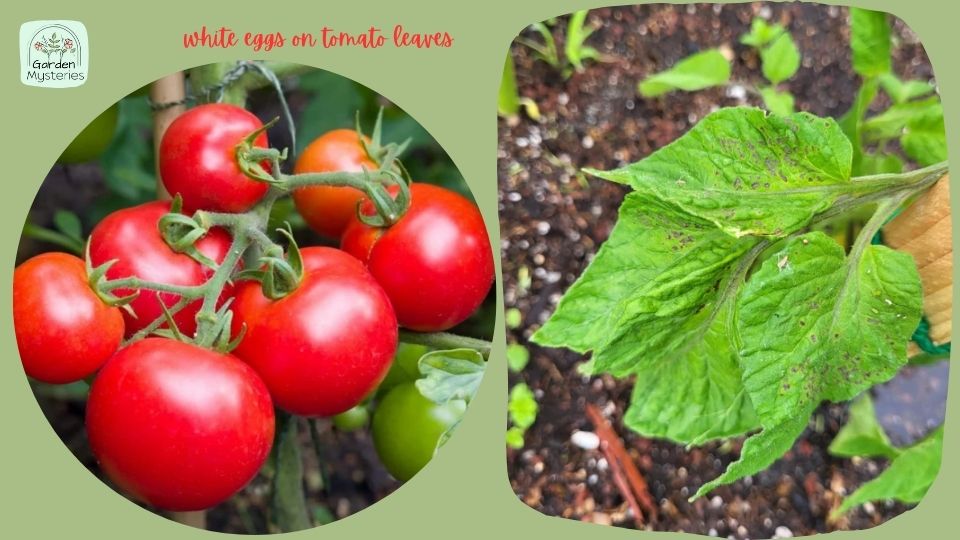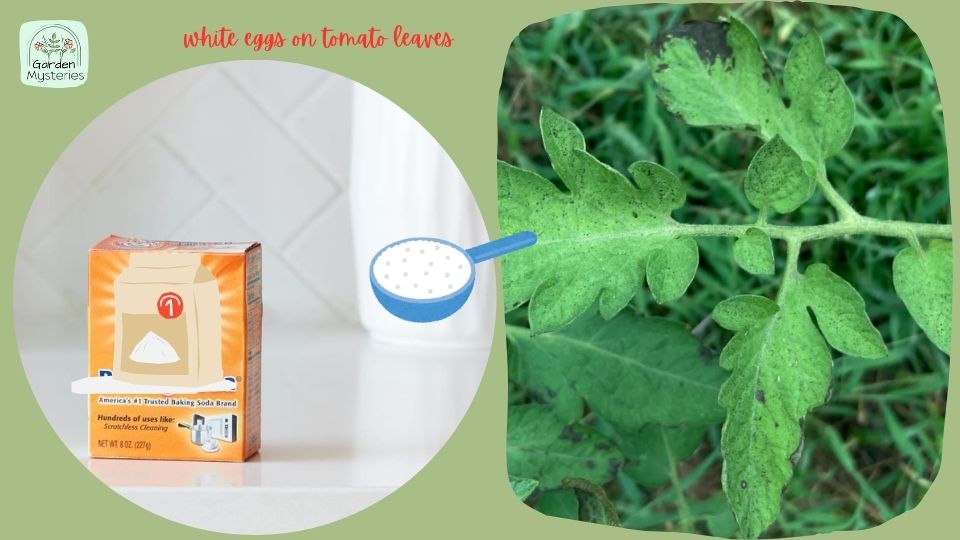My cousin harvested tomatoes in her backyard a few days back. Yesterday she told me that she saw black eggs on tomato leaves. Then, I discussed it with a professional and he told me about some easy tricks to get rid of them.
I discussed it with a professional and he told me that those black eggs on the tomato leaves are from various insect pests, including aphids, whiteflies, and thrips.
Also, he shared some tricks to get rid of those eggs to save my tomato plants. So, now I want to share those tips and tricks elaborately. Keep reading.
What Are the Black Eggs on Tomato Leaves?
The black eggs found on tomato leaves are often indicative of a pest infestation. These eggs are typically laid by various insect pests, including aphids, whiteflies, and thrips.
These tomato plant pests use the leaves as a suitable substrate to deposit their eggs, which then hatch into larvae that can cause damage to the plant. Also, the dark color of the eggs may be a result of the protective coating or secretion laid down by the insect to shield the eggs.
Identifying and addressing these eggs promptly is crucial to preventing a potential outbreak of pests that could harm the tomato plant’s health and yield.
Monitoring the plant regularly and employing appropriate pest management strategies like natural predators, organic sprays, or cultural practices will help prevent the eggs from hatching into destructive pests. Again, such pests and bugs can seriously compromise the overall well-being of the tomato plant.

Types of Bugs & Quick Solutions: At a Glance
Here’s a table summarizing common tomato plant pests, tomato bugs, and their solutions:
| Bug Type | Common Symptoms | Quick Solutions |
| Aphids | Curling leaves, sticky residue | Hose off with water or use insecticidal soap. Introduce ladybugs. |
| Whiteflies | Tiny white insects, with yellowing leaves | Use sticky traps, introduce parasitic wasps, and apply neem oil. |
| Thrips | Silver or white streaks, and distorted leaves | Remove affected leaves and introduce predatory mites and neem oil spray. |
| Tomato Hornworms | Defoliation, large green caterpillars | Handpick, use Bt (Bacillus thuringiensis) insecticide. |
| Spider Mites | Fine webbing, stippled leaves | Spray with water, apply insecticidal soap, and maintain humidity. |
| Cutworms | Cut stems at the soil level | Use physical barriers like collars, and handpick at night. |
| Slugs | Irregular holes, slime trails | Remove hiding places, handpick, and use beer traps. |
| Flea Beetles | Small holes, tiny jumping beetles | Apply floating row covers, use a neem oil spray. |
The effectiveness of these solutions may vary depending on the severity of the infestation and the specific circumstances of your garden. Always follow recommended guidelines for pesticide use and consider organic and environmentally friendly options when possible.
You can find vegetable gardening tips inside your balcony in this article.
How to Get Rid of Bugs on Tomato Plants?
Here’s an elaborate guide on how to effectively get rid of bugs on tomato plants using a variety of methods, including the solutions you’ve mentioned along with additional strategies:
Step 1: Identify the Pest
Start by identifying the specific pest affecting like green horn caterpillar your tomato plants. Moreover, different pests require different approaches for effective control.
Step 2: Physical Removal
Handpicking: For larger pests like tomato hornworms, caterpillars in tomatoes, and cutworms, manually remove them from the aphids plants and destroy them.
Step 3: Natural Predators
- Beneficial Insects: Introduce natural predators like ladybugs, lacewings, and parasitic wasps, which feed on various pests.
- Predatory Nematodes: Apply predatory Nematodes to the soil to target soil-dwelling pests.
Step 4: Barriers and Traps
- Floating Row Covers: Use these lightweight fabric covers to physically block pests from reaching your plants.
- Yellow Sticky Traps: Hang these traps near your plants to catch flying insects like whiteflies, aphids eggs and aphids.

Step 5: Companion Planting and Trap Crops
- Marigolds: Plant marigolds around your tomatoes to deter pests with their scent.
- Nasturtiums: These can attract aphids away from your tomato plants.
- Trap Crops: Plant sacrificial crops like radishes or nasturtiums to lure tomato plants pests away from your tomatoes.
Step 6: Organic Sprays Black Eggs on Tomato Leaves
- Neem Oil: Mix neem oil with water and a few drops of dish soap. Spray this solution on your tomato plants to deter and suffocate tomato plants pests.
- Chili Powder Spray: Mix chili powder, dish soap, and water in a spray bottle. Apply it to your plants to repel tomato bugs.
- Baking Soda Spray: Create a solution by mixing 1 tablespoon of baking soda for tomato plants, 1 teaspoon of mild liquid soap, and 1 gallon of water. Then, spray the solution on both sides of the leaves, ensuring good coverage. Avoid using baking soda spray for tomato plants during the hottest parts of the day.
Step 7: Soapy Water
- Insecticidal Soap: Mix mild liquid soap with water and spray it on your plants. Also, this disrupts pests’ cell membranes and leads to dehydration.
Step 8: Beneficial Microbes
- Bacillus thuringiensis (Bt): Use this natural bacterium as a liquid spray to target caterpillar and worm pests.
Step 9: Organic Dust
- Diatomaceous Earth: Apply this natural powder to deter crawling insects by damaging their exoskeletons.
Step 10: Cultural Practices
- Pruning: Remove affected leaves to prevent the spread of tomato plants pests and diseases.
- Proper Watering: Avoid overwatering, which can create a favorable environment for certain pests.
- Weed Control: Keep the area around your tomato plants free of weeds that could harbor pests.
Step 11: Rotate Crops
- Crop Rotation: Avoid planting tomatoes in the same spot each year to reduce the buildup of soil-borne pests and diseases.
Step 12: Regular Inspection
- Monitor: Regularly check your plants for signs of pests and act promptly if you spot any issues.
Additionally, you should remember that a combination of these methods, tailored to the specific pests you’re dealing with, will yield the best results.
It’s important to be persistent and proactive in your efforts to keep your tomato plants healthy and pest-free. Also, there might be white eggs on tomato leaves as well, we will cover another article on that soon.
Tips to Keep Tomato Plants Fresh and Safe
Here are some of the key tips to help you keep your tomato plants fresh and safe:
- Healthy Soil: Use well-draining, nutrient-rich soil for optimal growth.
- Proper Watering: Water consistently to keep the soil evenly moist, but avoid overwatering.
- Mulching: Apply organic mulch to retain soil moisture and prevent weeds.
- Support: Stake or cage tomato plants to promote airflow and prevent disease.
- Pruning: Trim lower leaves to avoid soil-borne diseases splashing onto leaves.
- Fertilization: Provide balanced fertilizer for healthy growth, but avoid excessive nitrogen.
- Crop Rotation: Avoid planting tomatoes in the same spot each year to prevent soil-borne pests and diseases.
- Companion Plants: Plant marigolds, basil, or other compatible plants to repel pests.
- Regular Inspection: Check plants for pests and diseases regularly.
- Early Intervention: Act quickly if you spot any issues to prevent them from spreading.
- Optimal Spacing: Plant tomatoes with enough space for air circulation to minimize disease risks.
- Sunlight: Ensure plants receive at least 6-8 hours of sunlight for best growth.
- Hygiene: Clean gardening tools and remove debris to prevent disease spread.
- Disease-Resistant Varieties: Choose tomato varieties bred for disease resistance.
- Prudent Pruning: Trim excessive foliage for better air circulation but don’t over-prune.
- Protect from Pests: Use barriers, traps, and natural predators to deter pests.
- Weather Protection: Cover plants during extreme weather to shield them from stress.
- Timely Harvesting: Harvest ripe tomatoes promptly to prevent overripening or pest attraction.
- Stay Observant: Continuously monitor plant health and respond accordingly.
Also, remember that tomato care involves a mix of proactive measures and timely responses to keep your plants thriving and disease-free.

FAQs
Can these black eggs harm other plants in my garden?
While they are specific to tomato leaves, some pests can infest multiple plants. Regularly inspect nearby plants for signs of infestation to prevent the spread.
Are there any preventative measures to avoid black eggs on tomato leaves?
Maintaining good garden hygiene, practicing companion planting, and regularly inspecting your plants can help prevent pest infestations and the presence of black eggs.
How do I differentiate between black eggs and beneficial structures on my tomato leaves?
Beneficial structures like ladybug eggs might be mistaken for pests. Also, you need to educate yourself on the appearance of various eggs to ensure you’re only removing harmful ones.
To find out which fertilizer would be the best pick for tomatoes, you should have a look at this article. Moreover, I heard some people are even discussing Earthgro vs Black Kow which is another fact to talk about later.





